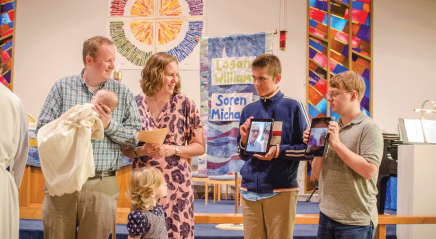How does the digital era both help and hinder our spiritual development? How can Lutherans leverage digital technology’s attributes—and respond to its challenges?
These were the questions Living Lutheran put forward to three ELCA experts on the topic, who guide us through the complex relationship between our spiritual lives and technology by offering their responses here.
Their backgrounds and perspectives on how Lutherans should respond to the digital age are distinct, but each agrees that the church has a unique role to play in this cultural moment.
Distracted? Read on …
By Susan Barreto
We live in a society that struggles to focus. Most of us blame our smartphones and other technology, often sold as a way of bringing us closer together.
In a few clicks, we can post photos and messages to all our friends and family at once. News is instantly at our fingertips, anytime, day and night. Yet the very technology designed to save us precious time in any number of daily tasks often leaves us feeling unaccomplished at the end of the day.
In the cacophony of beeps and dings urging us to take action, there is a subtle shift happening in how we view our technology and our spirituality. We often view spirituality as peaceful and gadget-free, yet we increasingly access spiritual messages via social media and podcasts.
Both technology and our human spirit demand our attention. Each has a claim on what it means to be human, and both seek to define what being a “righteous human” means in the 21st century.
Some people have even speculated that technology will ultimately replace our spirituality. Futurists point to the power of artificial intelligence and, more specifically, the inevitable point of “singularity,” when the intelligence derived by machines surpasses that of humans (Google search aside!). Predictions vary widely, but most observers say we’re hurtling toward that eventuality at breakneck speed.
In Silicon Valley, the idea of an “artificial intelligence god” gained steam in 2017, when self-driving-car engineer Anthony Levandowski established the Way of the Future church. According to organizational materials, the movement centers on “creating a peaceful and respectful transition of who is in charge of the planet from people to people plus machines.”
Both technology and our human spirit demand our attention.
The idea of people and machines being in charge, removing God from the equation altogether, is a far cry from the Lutheran ideal of grace.
Technology is viewed by some simply as a way to extend and improve human life. Proponents of “transhumanism” suggest we could outlive our current bodies with the help of technology, perhaps uploading ourselves into a server as bodies become sleeves for our immortal consciousness.
This notion of us becoming our own saviors through technology reveals a belief that religion and technology are in conflict. But each provides us with a mirror to our current reality, as well as a lens focused on the future and how to improve it.
If we take our eyes off our screens long enough to appreciate the world around us, we can also take solace in where we see God. God is in, with and under all that is around us, as detailed in Colossians 1:16: “In him all things in heaven and on earth were created, things visible and invisible … all things have been created through him and for him.”
ELCA Lutheran theologian Philip Hefner sees the creation and use of technology as not only a human enterprise but also a God-infused one. In Technology and Human Becoming (Augsburg Fortress, 2003), he wrote: “If we are to speak of religion, it must be a religion that encompasses the human life that is cyborg and technosapiens. It cannot merely be a religious way of dealing with technology, as if technology were somehow external to who we are.”
New medical devices, smartphone apps, even our Wi-Fi connectivity—each has a piece of God’s very creation within it, as do the developers who make the invisible visible every day.
Considering technology as our ultimate savior and life-giver is problematic; worshiping a powerful algorithmic god is short-sighted. Within any computer code lies a human being created in the image of a loving God—who, in turn, supports the human intellect as it seeks to surpass itself.
Encountering God in online spaces
By Kathi I. Johnson
My husband and I met 17 years ago. While many of my friends found their significant others at college, in a bar, at church or in some other physical location, Steve and I were the first ones I knew who had met online, begun dating and, eventually, gotten married.
I remember being nervous to tell my grandmother how I had found this new person in my life. She listened and then simply responded, “Well, if God can have people meet in other ways, why not on the internet too?” Indeed.
In the years since, I’ve developed relationships with many dear friends via the internet. Some I’ve seen in the flesh and some not. Whatever the case, the depth of some of these friendships has shown me one way to encounter God in online spaces. We pray for each other, we vent, we share ideas, we share our lives. When one of us is struggling, we hold space for that struggle. When one of us is rejoicing, we also rejoice.
Besides these friendships, though, I’ve found my spirituality deepened in other ways. I scroll through Instagram, see beautiful photos and marvel at God’s creative work. I scroll through Facebook and Twitter and see myriad concerns for prayer and myriad reasons to give thanks to God. I find religious texts and prayers to read, and some of my colleagues share their sermons online. In all these ways, I encounter God in online spaces on a regular basis.
When I began a doctoral program in preaching in 2017, I had been sharing my sermons online for several years. As part of my doctoral work, I began a ministry called Digital Gathering. Through regular broadcasting on Facebook Live, Digital Gathering has become what our mission statement calls “a place to explore through Scripture, prayer, and reflection.” I offer a reflection set in a short liturgy, which includes a Scripture reading and several moments of prayer.
This message of good news can and should be shared near and far.
For some people, these videos have become a holy pause in their busy lives—a time set aside for quiet reflection and prayer; an opportunity for a few moments of Sabbath rest. A time to encounter God in an online space.
When I’ve told others about my ministry online, some people honestly question if anything good can exist on the internet. There is, after all, so much evil to be found online—so much that can damage our relationship with God and destroy human relationships.
But isn’t that life? Don’t we find that everywhere? The world, our families, our workplaces and schools, and even our churches are filled with damage and destruction, along with the resulting pain and grief.
As people of faith, we aren’t called to deny the existence of evil, wherever it may be. Rather, we are called to remember that God has “reconciled us to himself through Christ, and has given us the ministry of reconciliation; that is, in Christ God was reconciling the world to himself, not counting their trespasses against them, and entrusting the message of reconciliation to us” (2 Corinthians 5:18-19).
God has reconciled the world to Godself and entrusts the message of reconciliation—the message of the gospel—to us. This message of good news can and should be shared near and far. We have the ability now more than ever before to tell others about God’s love for them.
Many of us shop, order food, connect with friends and family, read and write online; tweet, post and share online; mourn with those who mourn and laugh with those who laugh online. Given this range of very human activities, it makes sense that, in online spaces, we can meet the same God who came to live as one of us in the person of Jesus Christ.
Opportunity and caution
By Craig Mueller
I don’t think of myself as someone who uses a smartphone that often—yet I count 80 apps on my device. I depend on it to stream music, play podcasts, find and pay for parking spaces, determine the quickest route somewhere, forecast the weather, make appointments and much more. I also use it for spiritual purposes through meditation and daily prayer apps.
Congregations now use technology not only for websites but also to connect with people, post on social media, send e-newsletters and livestream worship services. Many faith communities use some or all of this new media to bring the gospel to people in innovative and creative ways.
Sometimes these efforts bring new people to existing worship communities; other times individuals pick and choose what speaks to them, without affiliating with any congregation. (Many people today, after all, identify as “more spiritual than religious” and may not feel comfortable being part of a church.)
In the past decade or so, technology has revolutionized our daily lives in ways we could have never imagined. Just as the printing press fueled the Reformation by distributing knowledge and increasing literacy, now social media allows people to create, share and collaborate, making religious and spiritual practices available to everyone.
There is, of course, another side to technology. Our smartphones can entice us away from exercise, reading, face-to-face relationships, nature and more. Given a spare moment, I might get out my phone rather than observe people or creation. When we live our lives online 24/7, we surrender to a frenetic urgency. Many of us find it hard to relax and enjoy unplugged moments of reflection and leisure.
Though we may wish we had more willpower to turn off our phones, creators of apps and programs design them to break down our resistance. Our phones are irresistible and addictive. I wonder whether our churches should provide opportunities to discuss and model a periodic detachment from technology.
Resistance to our always-on, workaholic culture should begin with congregations.
Jewish theologian Abraham Joshua Heschel argued that industrial and technological advances have made us less aware of the beauty of creation and our common humanity. Rather than fixating on building, mastering and conquering space, we should receive the gift of time represented by Sabbath observance.
In The Sabbath (Farrar, Straus and Young, 1951), he wrote: “There is a realm of time where the goal is not to have but to be, not to own but to give, not to control but to share, not to subdue but to be in accord.”
Biblical scholar Walter Brueggemann holds up the Sabbath as an act of resistance: Our ancient faith holds up a day of rest from the demands of consumption and production. Sunday worship is countercultural, helping us to distinguish its meaning and grace from the efficiency and moneymaking that guide the rest of our week.
Though it’s fashionable to use technology in creative and effective ways in worship, some people may feel refreshed by an unplugged service that reminds them to breathe deeply, be still and then depart, newly centered and awakened to nature and a slower pace of life.
The gifts of technology are clear to most of us. In fact, we are dazzled by what each new smartphone can do. Perhaps the time has come for the church to help us find the rest and renewal missing for more and more people.
Resistance to our always-on, workaholic culture should begin with congregations and religious leaders. What if we were to intentionally detach from commerce and media for a day, a half day or a couple of hours? This may sound radical, but so is God’s desire to give us rest and renew our weary bodies and souls.











